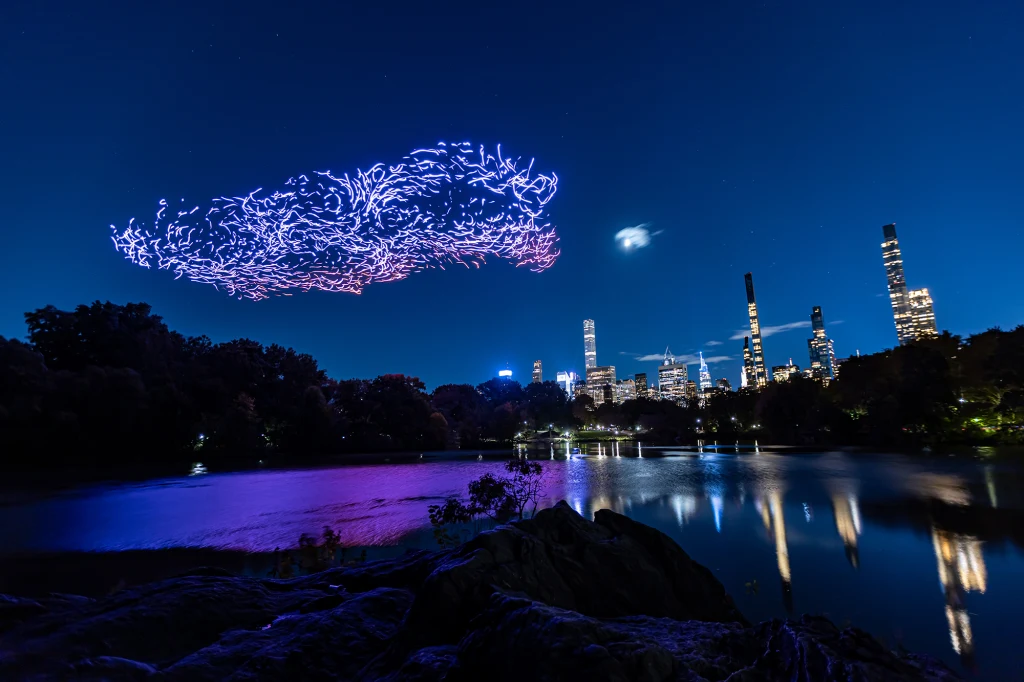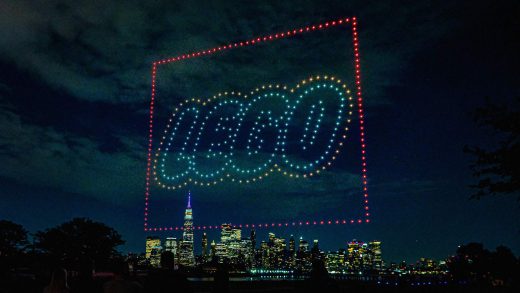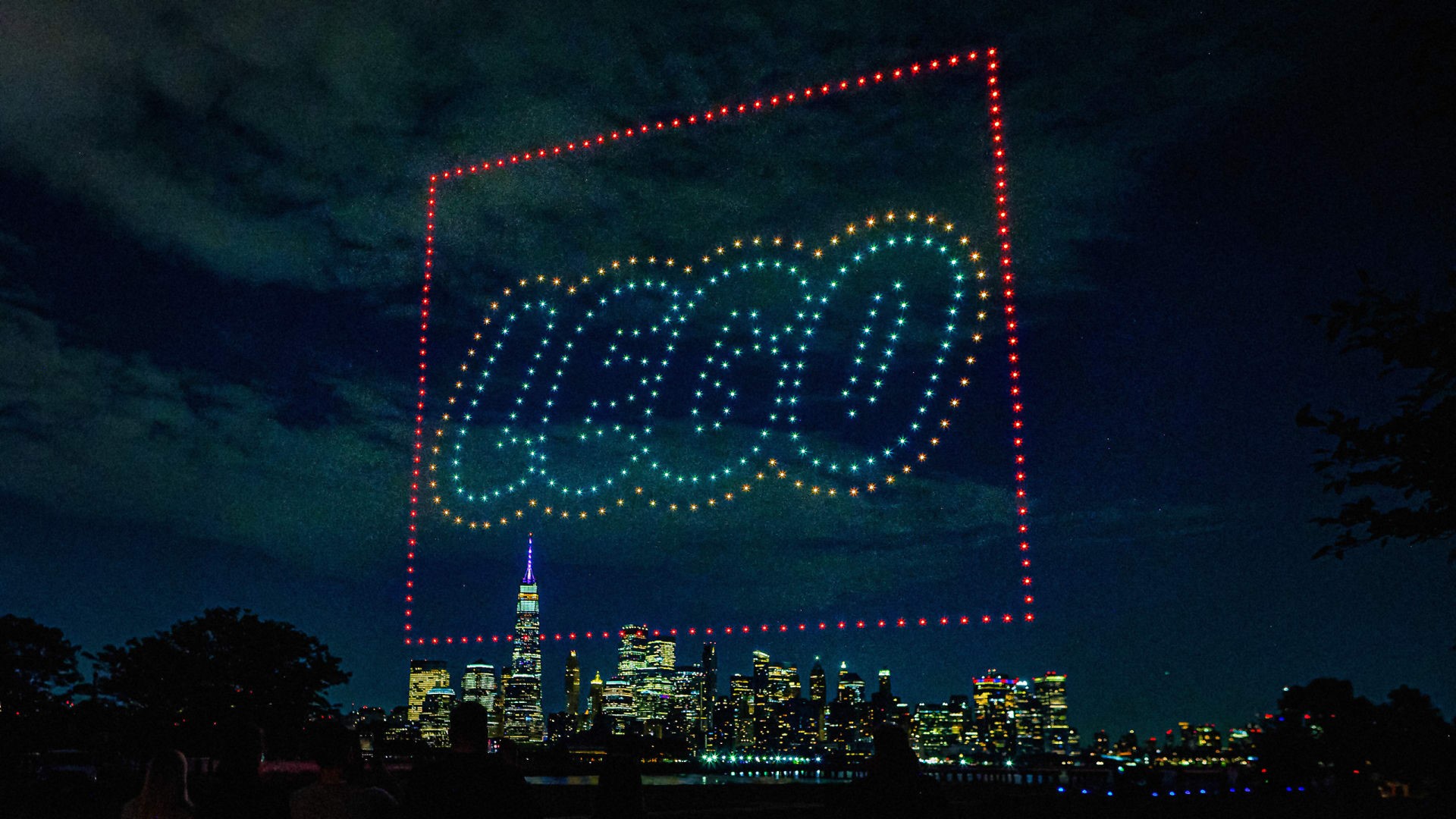How the sky became a giant billboard
July 09, 2024
How the sky became a giant billboard
Brands like Lego, GE, and Netflix are using drone shows to promote their products and services. But who does the sky belong to?
Quick, think. You’re the CMO of a big brand, and you need to make a splash with your next campaign. You have the cash, but billboards are passé, TV is a bore unless it’s the Super Bowl, and the internet says that influencer marketing is out. What do you do?
An increasing number of brands have been turning to an unlikely place to promote their products and services: the sky. And they have used an increasingly popular tool to do it. In the past few months alone, Lego Group flew 400 drones over the Hudson River in NYC to promote its upcoming space-themed sets, General Electric flew 1,000 drones to celebrate the company’s split into three independent public companies, and Netflix lit up the Hollywood sky with 2,000 drones to kick off its Netflix Is a Joke festival. Brands that have used drone shows in recent years also include Bulgari, Marvel, Paramount+, and Hyundai’s luxury vehicle division Genesis.

The sky has become one giant billboard, but the privilege to advertise with a swarm of blinking drones comes at a price, which is why the common denominator in the above list is big brands with deep wallets. Lucas Van Oostrum is the cofounder of Drone Stories, a drone light show company that’s created shows for some of the world’s biggest companies, including Samsung, Spotify, Mercedes, F1, and Lego Group. While he wouldn’t divulge exact costs for each of these contracts, he says a single drone show can cost anywhere from $50,000 to $1 million, with most drone shows the company designs hovering in between $100,000 and $300,000. For many small businesses, that would be a serious budget-buster. But for companies like Lego Group, which generated over $9 billion in revenue in 2023, it’s practically nothing.
For Alexander Chernev, a professor of marketing at Northwestern University’s Kellogg School of Management, the high cost of a drone show creates a barrier to entry for smaller companies and therefore makes it easier for big brands to stand out. This is a welcome perk, he says, but the reason brands find drone shows so appealing in the first place is that they are an effective way for companies to tell their story on the biggest platform in the world. “Brands are a set of associations that exist in people’s mind, and you need to create those,” he says.
Take Lego Group’s latest drone show. Titled UPO, for “Unidentified Playing Object,” the show was born after the team asked kids from all over the world to submit designs for what the spacecraft of the future could look like. The Lego team selected six winning ideas from kids in the U.K., U.S. Hong Kong and Denmark, including a dinosaur with jetpacks, flying saucers with night vision goggles, and a butterfly-winged bed with a snack drawer. They then worked with Didac Perez Soriano, associate master builder at Lego Group, to transform the kids’ drawings into actual brick models, and then again with Drone Stories to translate those models into a drone show. “We liked the idea of displaying the UPOs as a drone show because it offered a lot of creative opportunity and the chance to showcase them as close to space as possible,” says Beth Mckenna, the U.S. head of marketing for Lego Group.
To bring the drone models to life, the team animated the kids’ proposals so anyone looking up on May 22 may have noticed a bed with butterfly wings slowly flapping in the night sky. “What we wanted to do is take kids’ creativity and link it to space, and we wanted to find a way to share that with has many kids as possible,” says Dan Meehan, creative lead for the Lego Space theme, who was involved in the UPO show.
It’s important to remember that Lego Space was among the first three official play themes to launch, the other two being Lego Castle and Lego City. The idea was to have themes representing the past (Castle), the present (City), and the future (Space.) By putting on a “drone spectacular”—as the company described the show in a press release—Lego Group showed the world that play and creativity remain core to the brand, all the while driving awareness for the company’s Space theme.
The “UPO” creations will not be commercialized, but the brand is launching a couple of new sets this year, including Lego Art The Milky Way Galaxy, and the Lego Icons NASA Artemis Space Launch System. (Meanwhile, the UPO creations were displayed earlier this month at an exhibition at Lego House in Billund, and will be part of a touring exhibition across the U.S. this summer.)

A brief history of “sky marketing”
The fact that big corporations can so easily turn the sky into one big advertising machine is certainly outrageous, but it isn’t the first time that the sky is being commodified. In 1922, a mysterious phone number appeared in the Manhattan sky, just above Times Square. The number, which was made of smoke, belonged to a hotel that ended up receiving more than 47,000 calls in under three hours. Skywriting was born, and companies like Pepsi, Ford, Chrysler, and Lucky Strike soon followed suit with their own campaigns. Pepsi was so fond of the idea that in 1940 alone, they scribbled their logo more than 2,000 times, across dozens of locations across North and South America.
Skywriting faded sometime in the ’50s, only to be replaced by banner planes. The United States’ oldest aerial advertising company, for example, was founded in 1945 and to this day, it has worked with a wide roster of clients from local casinos, to the Philadelphia Inquirer to, surprise surprise . . . Pepsi.
Over the past few decades, though, skywriting has been making a bit of a comeback with brands like Cool Moon Ice Cream and even Uber taking to the skies. According to The Atlantic, the concept may be ephemeral, but its resurgence is likely fueled by the promise of eternal life on Instagram.
Chernev from the Kellogg School of Management says that companies have yet to figure out how to measure the degree to which such marketing campaigns contribute to brand building, but being able to beam the message as far as the internet will reach has been a key strategy. McKenna from Lego Group says the drone show, which they turned into an hero film and posted on Instagram and YouTube, was a success, and the Instagram Reel they created for the occasion has garnered 10 million views.

“There is plenty of sky”
For now, the sky belongs to the wealthy. But according to Van Oostrum from Drone Stories, the landscape is changing, and as the cost of hardware goes down, so will the cost of a drone show.
Together with Elon Musk’s younger brother Kimbal, and a few others, Van Oostrum recently cofounded a separate company called Nova Sky Stories, which in 2022 acquired 9,000 light drone shows from Intel. These drones, which were used during the Tokyo 2020 Olympic Opening Ceremony, are equipped with advanced hardware and software, and Van Oostrum says that acquiring them will allow Nova Sky Stories to reduce costs by leveraging direct access to cutting-edge technology. “In the end, these types of shows will be a commodity and what you pay for will be the creative and the local production cost,” he says.
Easing legislations might help bring down a few more barriers. When Drone Stories flew more than 1,000 drones over Central Park last year, they had to work with 23 city agencies to change the rules and open up the airspace. The approval process took them five years (but went ahead despite outcries about its impact on bird migration.) Now, he says they can fly drones “almost everywhere,” barring Washington, D.C (a No Drone Zone) and the approval process is drastically shorter: “In the U.S., we can fly almost everywhere within a few days, in Europe it’s a month.”
But will drone shows still feel novel if every brand starts doing them? We’ll have to wait and see, though Chernev believes we are far from saturation. “There are many different ways in which this can evolve but companies are looking for empty space that they can use to promote their services and brands, and there is plenty of sky,” he says.
If we do run out of sky, maybe someone will revive Coca Cola’s plans to beam a logo on the moon, or even Elon Musk’s plans to launch billboards into space. What could go wrong?
ABOUT THE AUTHOR
Fast Company
(16)



